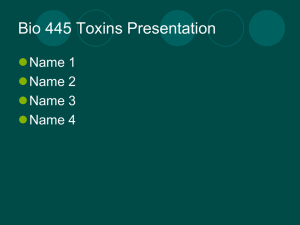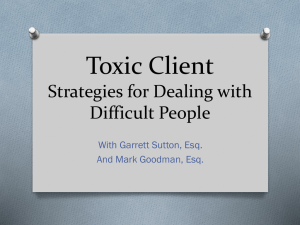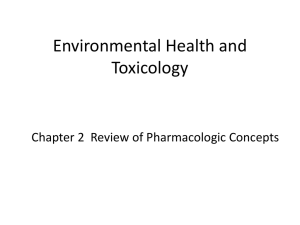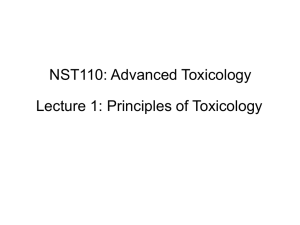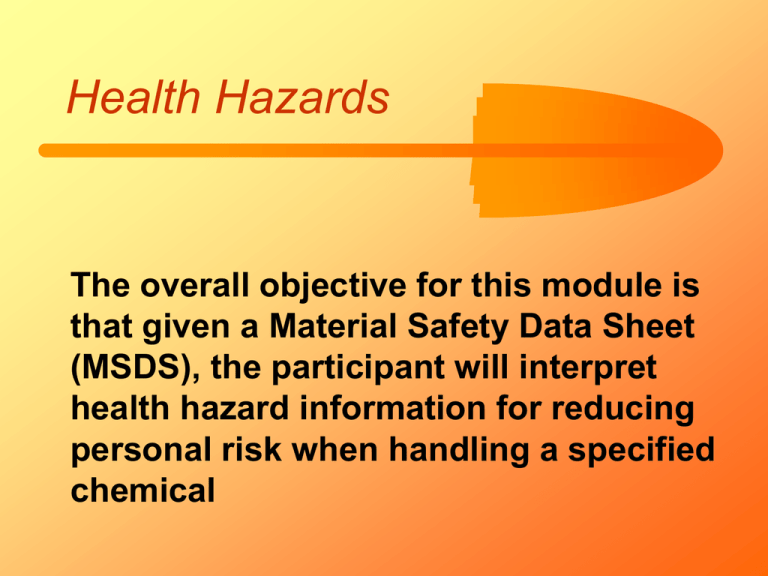
Health Hazards
The overall objective for this module is
that given a Material Safety Data Sheet
(MSDS), the participant will interpret
health hazard information for reducing
personal risk when handling a specified
chemical
Overview
• Terms and definitions that will help
you identify potential health hazards
• Types of common health hazards and
how to work with them appropriately
• How to use the Material Safety Data
Sheets to find health hazard
information about a chemical
Expectations
• Define the terms: LD50, LC50, TDlo, and TClo,
PEL, TLV, IDLH, and Threshold
• Define the hazards; irritant, corrosive, sensitizer,
carcinogen, teratogen, mutagen, reproductive
toxin, anesthetic, and asphyxiant
• Identify the four routes by which toxins enter the
body
• List five methods workers can use to reduce
exposure to toxic chemicals in the workplace
• Use the Material Safety Data Sheet to identify the
health hazards of a chemical
What
is a
Health Hazard?
Health Hazard
• Chemical, mixture of chemicals, or pathogen for
which there is statistically significant evidence
based on at least one study, conducted following
established scientific principles, that acute or
chronic health effects may occur in exposed
employees.
• Examples: reproductive toxins, carcinogens,
hepatotoxins and neurotoxins
Health Hazard
• Damaging or harmful
• In the early sixteenth century,
Paracelsus pointed out: “All
substances are poisons; there is
none which is not a poison. The right
dose differentiates a poison and a
remedy.”
Toxicology vs. Toxicity
• Toxicology
– Study of toxins and poisons
– Includes how toxins and poisons will
interact in living organisms
• Based on epidemiological studies
• Based on animal studies
Toxicity
• Rates the potential for harm of a
substance
• Low toxicity means relatively low
risk; high toxicity means high risk
for harm
Factors Affecting Toxicity
• Dose (concentration over time)
• Route of exposure (entrance)
The Hypothetical Dose /
Response Curve
• Dose-Response Relationship
– Relationship between the dose of a chemical
and the response that is produced by that
chemical in a biological system
• Dose-Response Curve
– Show the relationship between the time of
exposure to a specific amount (dose) and the
effects (response) a material has on an
experimental group
Average Population
Less Sensitive
More Sensitive
Response
Dose
LD50
Toxic Dose is based upon normal
distribution and average health.
Genetic variability is a major factor.
Levels
• Effective Dose
– Amount of a toxin at which there is a
response
– Referred to as threshold or odor threshold
• Threshold
– The concentration at which toxic effects are
first detected
Individual Response
• LD50 / LC50 (Lethal Dose 50% and
Lethal Concentration 50%)
– Calculation of dose / concentration of a
substance that is expected to kill 50
percent of a defined population
Individual Response
• TDlo and TClo (Toxic Dose Low and
Toxic Concentration Low)
– The lowest dose or concentration of a
substance which produces any toxic effect
– Dose or concentration is usually lower than
the LD50/LC50
Exposure Limits
• Airborne concentrations of a material
to which nearly all individuals may
be repeatedly exposed without
adverse health effects
• Help eliminate the factor of genetic
variability
Exposure Limits
• ppm or ppb
– used with liquid, vapor, and gas
• mg/m3
– used with solid particulates suspended in
air
Exposure Limits
•
•
•
•
•
•
•
Permissible Exposure Limit (PEL)
Threshold Limit Value (TLV)
Recommended Exposure Limit (REL)
Time-weighted Average (TWA)
Short-term Exposure Limit (STEL)
Ceiling (C)
Immediately Dangerous to Life Or
Health (IDLH)
Exposure Limits
• Permissible Exposure Limits (PEL)
– Legally enforceable standard established by
OSHA
• Threshold Limit Values (TLV)
– Guidelines established by American Conference of
Governmental Industrial Hygienists (ACGIH)
• Recommended Exposure Limit (REL)
– NIOSH workplace exposure concentration; 10
hour average
Exposure Limits
• Time Weighted Average (TWA)
– 8 hour day
– 40 hour week
– 52 weeks year
Exposure Limits
• Short Term Exposure Limit (STEL)
– Allowable limit for a maximum of four
continuous 15 minute exposures in an
eight-hour day
• Ceiling (C)
– Concentration that may never be exceeded
at any time
Exposure Limits
• Immediately Dangerous to Life or
Health (IDLH)
– Atmospheric concentration of any toxic,
corrosive, or asphyxiant substance
• Poses an immediate threat to life
• Cause irreversible or delayed adverse health
effects
• Interfere with an individual’s ability to escape
from a dangerous atmosphere
Toxic Concentration
Less than 1.0 mg/kg
1- 50 mg/kg
50 - 500 mg/kg
500 - 5,000 mg/kg
5 - 50 g/kg
Dangerously Toxic
Highly Toxic
Toxic
Moderately Toxic
Low Toxic
Toxic Dose
(quantity vs time of exposure)
The smaller the number
the more toxic the dose!
Cautions and Limitations for
PELs or TLVs
• Never be used:
– Fine lines between safe and dangerous
concentrations
– Evaluation or control of community air
pollution
– Estimating toxic potential of continuous
exposure
– Proof of an existing disease or physical
condition
Route of Toxins in the Body
•
•
•
•
Inhalation
Absorption
Ingestion
Injection
Route of Toxins in the Body
• Inhalation
– Most common toxic dose in the
occupational environment
Route of Toxins in the Body
• Absorption
– Most common route of entry for the worker
Route of Toxins in the Body
• Ingestion
– Most common route in the home
Route of Toxins in the Body
• Injection
– Occurs through puncture, tearing or
shooting of materials through the skin by
high pressure
Exposure and Effects
• Acute: Single exposure which occurs
within 24 hrs; effect within 72 hrs
• Chronic: Low level exposure over a
long period; effects delayed for weeks
or decades
Acute Response
•
•
•
•
•
•
Headaches
Dizziness
Nausea
Eye, skin or respiratory damage
Unconsciousness
Death
Chronic Exposure
• Frequently not reversible
• Liver, kidney, lung damage
Target Organs
• Affected by poisons:
– CNS
– Circulatory system
– Blood and blood forming systems
– Visceral organs (liver, kidneys,
lungs, etc.)
– Skin
Local and Systemic Toxicity
• Local: Effect of toxin at site of first
contact
• Systemic: Effect of toxin after being
absorbed into the body
Elimination of Toxins
• Liver
– Filters toxins out of the blood and chemically
changes them into less toxic compounds
• Kidney
– Filters approximately 45 gallons of plasma every
day waste products are passed from the kidneys
to the bladder and then eliminated
• Lung
Substance Interaction
•
•
•
•
Additive 2 + 2 = 4
Synergistic 2 + 2 = 6
Potentiation 0 + 2 = 10
Antagonism 4 + 6 = 8
Response Factors
•
•
•
•
Substance
Exposure
Worker Characteristics
Environment
Response Factors
• Substance
– Chemical composition, physical
characteristics, stability, storage, and
solubility in body fluids
• Exposure
– Dose (Concentration over time) and route
of entry
Response Factors
• Worker Characteristics
– Level of toxicity, age and body weight,
nutrition, health and stress
• Environment
– Physical factors, social factors and other
chemicals
Toxic Effects of Chemical
Substances
•
•
•
•
•
•
•
Asphyxiants
Anesthetics
Irritants
Corrosives
Sensitizers
Carcinogens
Reproductive Toxins
Chemical Substances
• Asphyxiant
– Chemicals that deprive the victim’s body tissues of
oxygen
– Simple- Displace oxygen in the air
– Chemical- Competes with oxygen by interfering with
absorption and use of oxygen in the body
• Anesthetics
– Material that causes a loss of sensation or produces
unconsciousness
– Cause central nervous system depression
Chemical Substances
• Irritants
– Chemical, liquid, or solid that causes a
reversible inflammatory effect on living
tissue at site of contact
• Corrosive
– Chemical that causes irreversible damage
to living tissue
Chemical Substances
• Sensitizer
– Chemical that causes a substantial number
of exposed people or animals to develop
an allergic reaction in normal tissue after
repeated exposure to the chemical
• Carcinogen
– A carcinogen is any substance that has
proved or is suspected to increase the risk
of cancer in workers
Reproductive Toxins
• Mutagens
– Agents that cause an inheritable change in the
chemical structure of chromosomes in the cell
– Changes in the structure of sex cells may be
passed on to future generations
• Teratogens
– Substances that produce malformations of an
unborn child without killing the child or causing
physical harm to the mother
Reducing Your Exposure
• Know the identity of the chemical
and the concentration of that
chemical
• Use the MSDS
• Minimize your time working with
the material
• Wear the recommended PPE
• Use appropriate personal
hygiene





